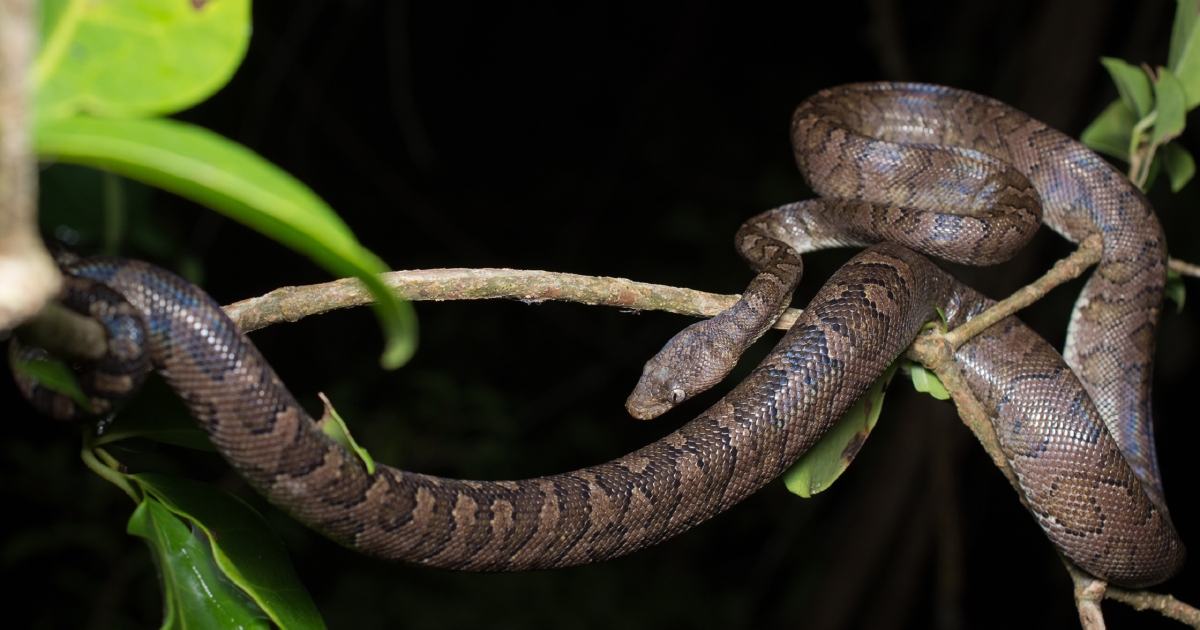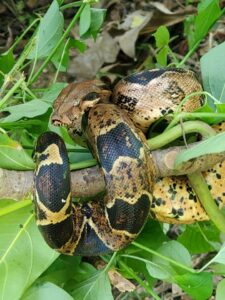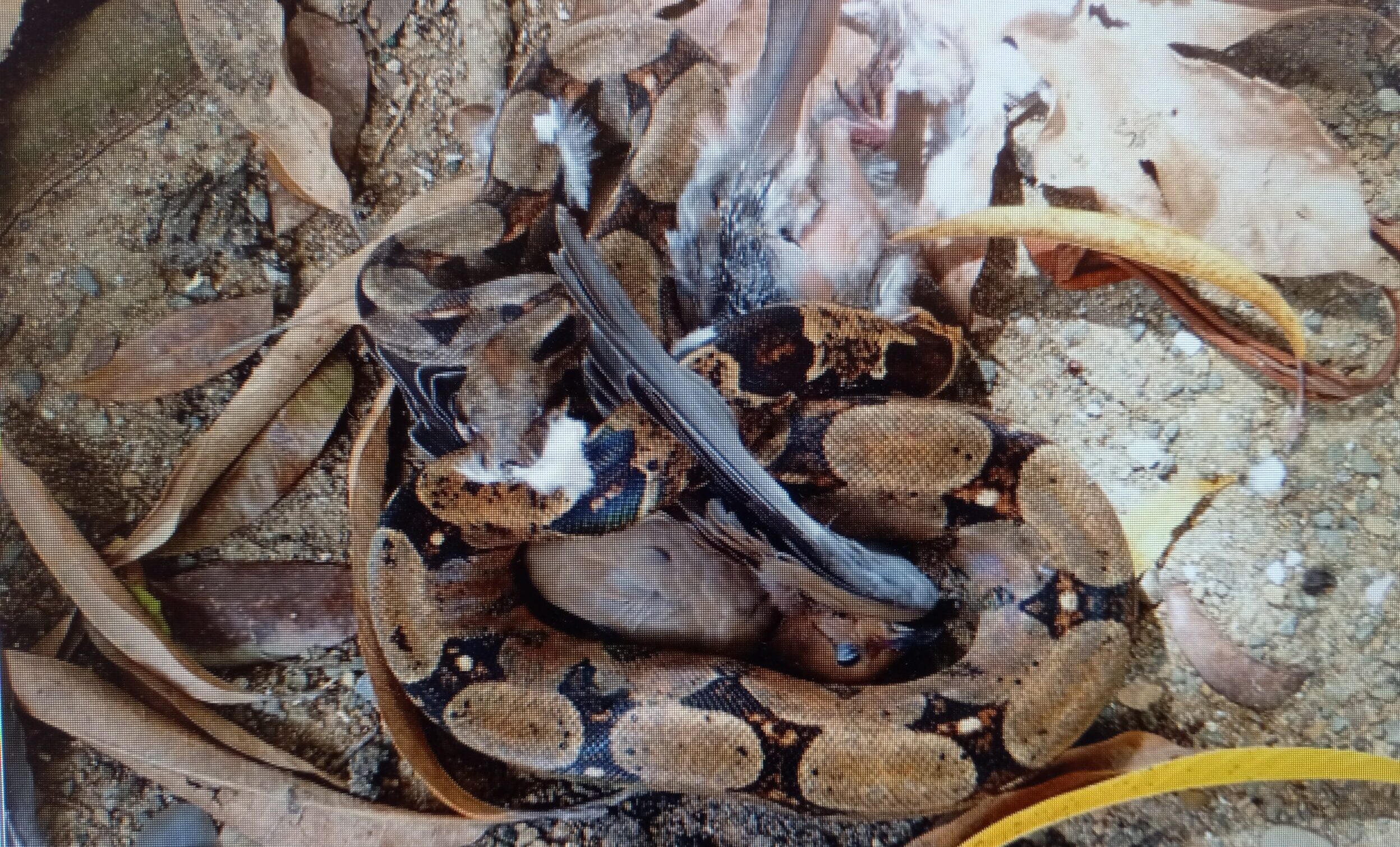
I always tell people that my office has become international. I get so many phone calls and email messages from around the world, as well as locally and nationally, from people looking for information on a wide range of topics such as the history, culture, and the natural resources of the Virgin Islands. I never thought in my short life here on Earth, although I am more than a half a century old, that I would be in such demand by the world public.

The other day, I got a text about snakes, particularly the red-tailed boa (Boa constrictor), which is becoming a major invasive species on the island of St. Croix. The text came from one of our local TSA officers. As I spoke to the person, it got me thinking to write an article about snakes, although I have written about snakes in the past. Then I really began to think and say, why not mention the Virgin Islands tree boa (Chilabothrus granti)?
In the general public, there might be confusion at times about which snake is a red-tailed boa and which is the Virgin Islands tree boa. The V.I. tree boa is a federally and locally endangered protected snake species that is native to the British Virgin Islands, U.S. Virgin Islands, and Mona Island between Puerto Rico and Hispaniola, but not on Puerto Rico itself. The V.I. tree boa’s scientific name has been changed from Epicrates monensis granti to Chilabothrus granti, which reflects the currently accepted taxonomy. According to the Federal Register, the “Virgin Islands tree boa is a distinct species, not a subspecies, and Epicrates is no longer the scientifically accepted genus for this species.”
Our native V.I. tree boa is a non-poisonous snake. In other words, completely harmless to humans. These are the only snakes in our region with a very distinct pattern. According to the late Dr. William P. MacLean, the Virgin Islands tree boa’s body and tail are covered with irregular crossbars in dark brown on a light gray-brown background. Their bodies are cream with irregular darker markings. Their necks are quite distinct, and their heads are covered with irregular, small scales. The snake grows between 3 to 4 feet long.
Historically speaking, V.I. tree boas are usually found on the East End of St. Thomas’ dry, tropical semi-deciduous forests. These snakes are active primarily at night and eat nice, rats, and other small creatures like sleeping lizards. The habitats of these snakes are threatened due to the rapid East End developments on St. Thomas. However, there are ongoing scientific research projects by the North Carolina Zoo in collaboration with our local Fish and Wildlife Division of the Department of Planning and Natural Resources to find out and learn more about the V.I. tree boa’s behavior in the wild. Believe me, it is our V.I. tree boa that keeps rats and other rodents in check within our island’s natural environment.

Nevertheless, the V.I. tree boa is not native to St. Croix and not found on the island. Like I mentioned earlier, it is native to the northern Virgin Islands and Mona Island. However, the red-tailed boa snake is becoming destructive to the wildlife population and the fear it has put in the people on St. Croix. Whenever I conduct a hike, I give rules and regulations, such as don’t touch plants — they might be poisonous — and stay behind the tour guide at all times unless I give you permission to be in front.
Also, I mention that we have wild exotic snakes on the island. The red-tailed boa snake is native to tropical South America. It is a large, non-venomous, heavy-bodied snake that sometimes can reach 13 feet long and is generally brown, gray, or cream in color, with patterns of brown or reddish-brown toward the tail. Thus, the name red-tailed boa constrictor.
The red-tailed boa (Boa constrictor) was brought into St. Croix illegally. It is against the law in the Virgin Islands to bring in exotic pets without getting permission from the proper authorities. The boa is becoming a nuisance to humans and wildlife on St. Croix. I have gotten reports where the red-tailed boa has eaten farmers’ chickens, roosters, eggs, and small animals. They also have eaten cats, iguanas, mongoose, wild birds, and small dogs.
While residents of St. Croix think the red-tailed boa lives in bushes or forest areas on the island, which they do to some extent, oftentimes these animals are being found in neighborhoods, backyards, or sometimes in somebody’s vehicle. This past year, there was a news release in the media telling residents in the Frederiksted area to check under the hood of your vehicle for snakes. Apparently, this species of snake loves warm areas.

I don’t know of any in-depth local ecological research studies on the red-tailed boa’s behavior and movement in the natural environment of St. Croix. There is a paper, titled “Introduction of an Exotic Constricting Snake (Boa constrictor) and Its Establishments on St. Croix, U.S. Virgin Islands,” written by Nicole E. Angeli, William Coles, Shane McKinley, and Daniel G. Mulcahy.
“The temperate, suitable climate for the boas and an abundance of domestic mammals on St. Croix facilitates further boa spread and establishment in the years to come. Cats, dogs, goats, rats, mice, deer, tortoises, and mongoose are free ranging. Smaller livestock including pigs, sheep, calves, and chickens may be impacted,” noted the research paper. What we generally know is that the red-tailed boa is viviparous, which means they give live birth. In other words, the red-tailed boa doesn’t necessarily need a male to breed.
These animals are nocturnal. However, it all depends on the species or subspecies. The young boa constrictors may climb into trees to forage or just to bask in the sun. They become terrestrial mostly once they become much older and heavier snakes. If you see a red-tailed boa, it wouldn’t run after you. The snake is afraid of you as much as you might be afraid of it. When they perceive a threat, they will strike. Their bite can be painful, especially from a large snake. However, these snakes are rarely dangerous to humans if bitten.
Most of the snakes being caught on St. Croix are from the west and northwest of the island. However, snakes have been spotted at Food Town, Grove Place, Salt River Bay, Market and Marley Community in Frederiksted area to the Estate Little Princess. It is a matter of time how far the boas would spread throughout St. Croix. Again, they might create a niche in the environment depending on many factors in the island ecosystem.
Bill No. 34-0023 was passed to establish the Invasive Species Eradication Community Program. As of now, there is a bounty on the heads of the red-tailed boa. There is money involved in catching the boa. However, you must be a certified wildlife control operator. There are nearly 30 certified operators on St. Croix to help the public with invasive species such as the boa. St. Thomas and St. John are not out of the loop. The boa constrictor can be carried by people if not caught by TSA officers or on containers (boat/ship) traveling to our sister islands. Please don’t handle the snake yourself. Contact the DPNR through its website or by calling 340 7731082.
— Olasee Davis is a bush professor who lectures and writes about the culture, history, ecology and environment of the Virgin Islands when he is not leading hiking tours of the wild places and spaces of St. Croix and beyond.





